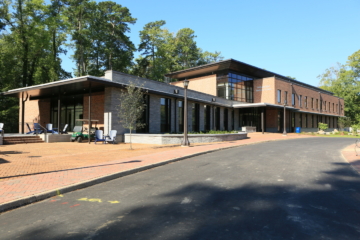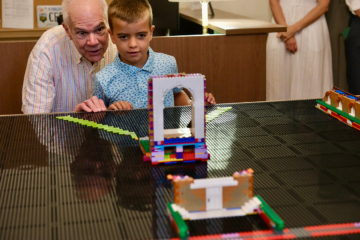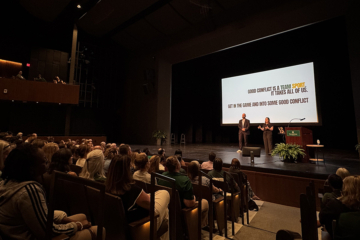Unforgettable lessons from Cherokee country
The following story originally appeared on the website for the Charles Center. – Ed.
Research is a dynamic process that takes many forms. Sometimes, to ask the right questions and gain nuanced understandings, immersion in a topic is necessary.
It’s a lesson that Buck Woodard, assistant professor of anthropology, instilled in his students during an innovative study away excursion May 18-25 to the Qualla Boundary to learn about Ani Kituwah, the Eastern Band of Cherokee Indians (EBCI).
Less than a year into his tenure at W&M, Woodard is expanding the reach of the university’s anthropology program by immersing his students in Cherokee history and culture.
Collaboration with Indigenous knowledge keepers is central to the hands-on experience.
“They’re a special group. They speak a different language, and they have a unique syllabary that they write in,” Woodard said. “They have a lengthy history with all the states around them, a history we tried to capture along the way.”

Last semester, Woodard set the stage with an innovative 1-credit course in ethnographic fieldwork, offering students training in anthropological methods and an introduction to Cherokee traditions. Students also examined Cherokee’s historical relationship with William & Mary, Williamsburg, and the Virginia Colony — all of which included collaborative instruction from visiting members of the EBCI.
But some understandings are simply impossible to glean at a distance.
The study away trip offered students a closely mentored opportunity to apply principles and methods explored in the classroom to guided ethnographic inquiry of the Cherokee Indian Reservation.
Woodard’s appreciation for the arts, as well as anthropology, is evident in the design of the study away program, which blended field research experiences with visits to Sequoyah’s Birthplace Museum, the collections of the Qualla Arts & Crafts Cooperative, and other key historical sites.
In the first W&M trip of its kind, students got the chance to tour the mother town Kituwah mound, hear fireside stories and indulge in a feast of traditional Cherokee foods, and participate in social dances at the Oconaluftee Indian Village.
The Eastern Band of Cherokee is an ideal field setting, Woodard explained, because “it’s the closest large tribe to William & Mary that has a historical relationship with Williamsburg, and that also has a body of literature representing them as a people — historically, culturally, religiously, and creatively.”
Drawing on relationships he has built with the Cherokee over the course of his life — at the Museum of the Cherokee People and through his social network — Woodard worked closely with EBCI members to organize the structure of the trip.

As they toured Cherokee infrastructure and interacted with different cultural practices, students applied research methods to studying how the politics and economy of the EBCI have evolved over time.
“I’m interested in their economy and how they’ve driven their economic development over the last 20 years, since it has changed quite a bit, to include gaming, for instance, and now multiple gaming facilities. But the revenue that’s come in from those ventures has allowed them to build tribal infrastructure they did not have before,” Woodard said.
He explained, “We looked at contemporary issues, but also historical ones and cultural traditions through time, and went out of our way not to be invasive or extract anything because we’re really working with people who are already public facing.”

Woodard enjoyed exploring the rich culture and history of the EBCI with his students as they “followed the footsteps” of the Cherokee on the two routes historically used to reach Williamsburg, where some attended school at the Brafferton and others negotiated political agreements.
Carving a trail along the Qualla Boundary and over the mountains to Tennessee, Woodard and his students sought “to try to re-engage some of that history” by visiting key cultural sites both inside and outside of Cherokee territory.
Over the course of their journey, students exercised their methodological muscles as they took field notes, conducted informal interviews, and built relationships.

“In Cherokee, we wanted to make sure we met people at differing socioeconomic levels and different cultural expectations and then practice some of our field methods of relationship-building and respect,” Woodard said. “We wanted to see how things function, what the structure and layout are; make observations that are both social and political, but also about class, race, and anything else we encountered.”
While encouraging students to identify interesting patterns to track in their ethnographies, Woodard emphasized the importance of respectful fieldwork and the centrality of Cherokee sovereignty.
As they live on the reservation, he said, it is important to recognize Cherokee as an independent sovereign with its own legal structure and unique culture.
Woodard hopes that this study away trip to Cherokee, supported by the Office of the Dean of Arts & Sciences and the Charles Center, highlighted Cherokee’s sovereign territory with its own “special status that we should recognize.”
Latest W&M News
- Student Health Center continues exceptional student care with AAAHC reaccreditationAAAHC accreditation, held by only seven universities in Virginia, recognizes the university's commitment to providing exceptional student-centered care.
- Brick by brick: W&M community to build model of its Historic CampusWilliam & Mary has launched a yearlong project to build a Lego model of its Historic Campus with the help of students, faculty, alumni and the Williamsburg community.
- Finding meaning in the danger zoneDavid Long explores how near-death experiences transform work through storytelling.
- Conflict as a catalyst for growth: W&M’s 2025 Professional Development DaysWilliam & Mary’s second annual Professional Development Days focused on navigating conflict.
- Energy sector leader Darpan Kapadia ’95 to speak at Opening ConvocationDarpan Kapadia ’95 will welcome new William & Mary students this month at Opening Convocation.
- Strategic Cultural Partnerships Faculty Fellows reshape America’s founding story as 2026 approachesEight W&M faculty awarded SCP fellowships to enrich historical narratives and strengthen civic leadership ahead of nation’s 250th anniversary.













